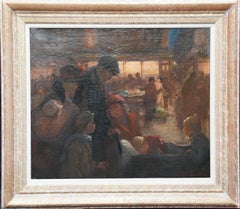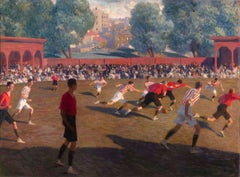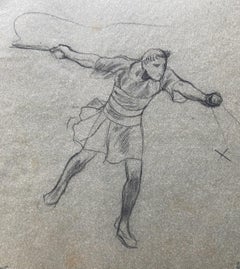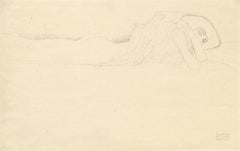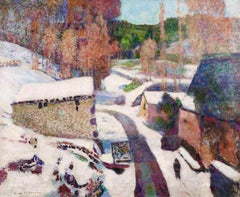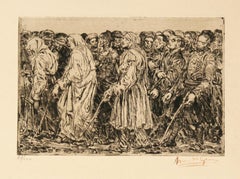1910s Art
to
270
1,085
356
394
190
170
Overall Width
to
Overall Height
to
7,548
21,290
159,126
232,531
1,970
2,247
4,945
6,411
5,814
13,319
19,780
25,692
18,300
13,586
5,389
411
314
138
138
47
20
19
12
6
1
1,228
884
32
1,427
690
593
409
386
351
216
151
144
137
132
122
115
100
97
92
77
76
59
57
866
629
486
396
385
95
52
34
23
22
852
363
1,171
951
Period: 1910s
Family Portrait in Market - British 1914 art Post Impressionist oil painting
Located in Hagley, England
This charming early twentieth century Post Impressionist portrait oil painting is by British Jewish female artist Amy Julia Drucker. Of German descent, Drucker was born in England i...
Category
Post-Impressionist 1910s Art
Materials
Oil
Football by Fedor Ivanovich Zakharov
By Fedor Zakharov (b.1882)
Located in New Orleans, LA
Signed in Cyrillic "F. Zakharov" (lower right) and signed again and inscribed "Fedor Zakharov/Football" (on reverse)
Oil on card laid down on panel
Undoubtedly, football, or socc...
Category
1910s Art
Materials
Oil, Panel, Cardboard
G. A. Rochegrosse (1859-1938) , Study for "Le Cocher" original drawing
Located in Paris, FR
Georges Antoine Rochegrosse (1859-1938)
Study for "Le Cocher"
carbon pencil on thin paper
14.5 x 13 cm
In good condition
Framed : 36.7 x 31 cm
Provenance: Estate of the artist and...
Category
Symbolist 1910s Art
Materials
Carbon Pencil
Gustav Klimt "2nd Study for Water Serpents" collotype from Funfundzwanzig folio
By Gustav Klimt
Located in Palm Beach, FL
Title page numbered: 263/450
Category
Vienna Secession 1910s Art
Materials
Paper
Murols sous la neige - Post Impressionist Landscape Oil by Victor Charreton
Located in Marlow, Buckinghamshire
Signed figure in winter landscape oil on canvas circa 1915 by French Post Impressionist painter Victor Charreton, who was known as the painter of colours. The work depicts a man stro...
Category
Post-Impressionist 1910s Art
Materials
Oil, Canvas
Les Aveugles ( The Blind )
Located in Paonia, CO
Henri DeGroux (1866-1930) was a Belgian Symbolist painter, sculptor and lithographer. He was known for his allegorical, religious and historical subject matter. He became an inspired...
Category
Symbolist 1910s Art
Materials
Lithograph
Ambulkance
Located in Paonia, CO
Henri DeGroux (1866-1930) was a Belgian Symbolist painter, sculptor and lithographer. He was known for his allegorical, religious and historical subject matter. He became an inspired...
Category
Symbolist 1910s Art
Materials
Lithograph
The Triumph of Bacchus, a large oil painting by Ferdinand Leeke
Located in London, GB
The Triumph of Bacchus, a large oil painting by Ferdinand Leeke
Oil-on-canvas, German, 1918
Frame: height 175cm, width 227cm, depth 10cm
Canvas: height...
Category
Romantic 1910s Art
Materials
Canvas, Oil
T-Wharf in Winter
Located in Bryn Mawr, PA
Provenance
Bonhams Skinner - Malborough, March 8, 1991, lot 226;
Private collection, Pennsylvania, until 2022
A painter especially known for street and waterfront scenes of Boston, ...
Category
American Impressionist 1910s Art
Materials
Oil, Canvas
Impressionist scene of the harbor in Raguse modern Dubrovnik In Summer sunlight
Located in Woodbury, CT
Arthur Croft Mitchell (British, fl. early 20th century)
Raguse (Ragusa / Dubrovnik), Croatia
Oil on canvas, circa 1910
Signed and titled Raguse on the reverse
Presented in the origin...
Category
Impressionist 1910s Art
Materials
Oil
Study for cover of Vogue magazine
Located in Fort Washington, PA
Study for the cover of the November 15, 1912 issue of Vogue magazine
A figural work depicting lovers figures, the recumbent male costumed as a masked Harlequin clown, the female sea...
Category
1910s Art
Materials
Paper, Mixed Media
Paris - Les Inondations - Impressionist Landscape Oil Painting by Maxime Maufra
Located in Marlow, Buckinghamshire
Signed impressionist oil on canvas landscape painting by French painter Maxime Maufra. The piece depicts people rowing boats through the flooded streets in Paris.
Signature:
Signed...
Category
Impressionist 1910s Art
Materials
Oil, Canvas
Femme Assie
Located in Fairlawn, OH
Femme assise
Etching with drypoint, c. 1920
Signed in pencil lower left
publisher stamp lower right
Edition: 100 (88/100)
Condition: Excellent
Image size: 11 3/4 x 8 1/4 inches
Cou...
Category
1910s Art
Materials
Drypoint, Etching
Warwick Castle - British art early 20th century painting river landscape autumn
By Henry Charles Brewer
Located in Hagley, England
A large, fresh and vibrant watercolour view of Warwick Castle which was painted in 1917. The view is captured in detail by Henry Charles Brewer RI who travelled widely and who exhib...
Category
Impressionist 1910s Art
Materials
Watercolor
Alexandra Exter Russian Avant Garde work on paper Signed ex-Solomon Shuster coll
Located in New York, NY
Alexandra Alexandrovna Exter
Colour Dynamic, 1918
Russian avant-garde watercolor and gouache on paper
Signed on the front
Collection of Solomon Shuster, Leningrad (with collection la...
Category
Abstract 1910s Art
Materials
Watercolor, Gouache
Impressionistic Portrait of the Equestrian Artist Baptista Schreiber - Drawing
Located in Stockholm, SE
This expressive and atmospheric graphite drawing by Gösta von Hennigs (1866–1941) portrays the celebrated equestrian artist Baptista Schreiber within the charged setting of a circus ...
Category
Impressionist 1910s Art
Materials
Paper, Graphite
"The Artist's Wife at the Loom, " Harry Hoffman, Bright American Impressionism
Located in New York, NY
Harry Leslie Hoffman (1871 - 1964)
The Artist's Wife (Beatrice Pope) at the Loom, circa 1915
Oil on canvas
30 x 32 inches
Housed in a period Newcomb-Macklin frame
Provenance:
Estate of the artist
Private Collection, Massachusetts
This painting depicts the artist's wife at the loom, producing textile versions of Hoffman's underwater paintings. The screen shown behind Bea is an underwater scene also painted by Hoffman. The study of this painting is held in the collection of the Wolfsonian Museum in Florida.
Harry Leslie Hoffman was born in Cressona, a small community in Pennsylvania's Schuylkill Valley. His mother was an amateur artist who encouraged her son to pursue a career in the arts. In 1893, Hoffman entered the School of Art at Yale University and studied with John Ferguson Weir, the son of Robert Walter Weir. After graduation in 1897, Hoffman moved to New York to continue his studies at the Art Students League. He also traveled to Paris and took classes at the Académie Julien.
In the summer of 1902, Hoffman attended the Lyme Summer School of Art, in the town of Old Lyme on the Connecticut coast. The school was headed by Frank Vincent Dumond and was located in a boarding house owned by Florence Griswold. The school eventually grew into an artists' colony and a center for American Impressionism. When Hoffman first arrived as a student, he was not permitted to stay in the house which was designated for the professional artists only. However, his outgoing personality soon won him many friends at the colony.
In 1905, Hoffman settled in Old Lyme and worked as a full member of the artist colony. He was particularly influenced by Willard Leroy Metcalf, an Impressionist also working in Old Lyme. Fellow artists later fondly recalled Hoffman's antics at the Griswold house, which included playing the flute and banjo, tap-dancing, singing humorous songs, and performing magic tricks. In 1910 Hoffman...
Category
American Impressionist 1910s Art
Materials
Canvas, Oil
"La Marre de Soire, " George Leonard, American Impressionist, Beach Seascape
Located in New York, NY
George Henry Leonard, Jr. (1869 - 1928)
La Marre de Soire
Oil on canvas
15 x 21 3/4 inches
Signed lower right
A landscape painter--primarily using a late impressionist loose stroke as his main mode of expression--Leonard drew not only upon French influences, but also the American school of impressionism characterized by Frank Boggs...
Category
American Impressionist 1910s Art
Materials
Canvas, Oil
Work by Léon Bakst - early 20th-century wartime propaganda Avant-garde
By Leon Bakst
Located in PARIS, FR
This striking work by Léon Bakst, titled “Le grand peintre russe nous promet pour bientôt…” (“The great Russian painter promises us soon…”), vividly captures the spirit of early 20th...
Category
1910s Art
Materials
Linen, Paper, Lithograph
American School Pasture Scene, 1911
Located in Astoria, NY
American School, Pasture and Woods Scene, Oil on Canvas, 1911, with farmhouse beyond, illegibly signed "Tain...(?)" and dated lower right, gilt composition frame. Image: 26.75" H x 3...
Category
American Impressionist 1910s Art
Materials
Canvas, Oil
Oil On Canvas, Art Nouveau Portrait By Leon Tirode (1873-1956)
Located in Gavere, BE
"Oil On Canvas, Art Nouveau Portrait By Leon Tirode (1873-1956)"
Old oil on canvas, Art Nouveau style, portrait "Autumn"
painted and signed by Leon Tirode (1873-1956),
French school...
Category
Art Nouveau 1910s Art
Materials
Gold Leaf
Adam and Eve
Located in Santa Monica, CA
Adam and Eve, 1910
Vintage photogravure, Camera Work April 1910, 30:5
Image: 7" x 5", Mount: 11-3/4" x 8-1/4", Mat: 20" x 16"
Category
1910s Art
Materials
Photogravure
G. A. Rochegrosse (1859-1938) Studies of men, original drawing
Located in Paris, FR
Georges Antoine Rochegrosse (1859-1938)
Studies of men,
Pencil on paper
23 x 41.5 cm
Signed lower right
In good condition
In a modern mount 41 x 52.5 cm
Provenance: Estate of the...
Category
Symbolist 1910s Art
Materials
Carbon Pencil
Mother and Child
Located in New York, NY
Watercolor on paper laid on board: An exceptional watercolor in terms of quality and presentation. During this earlier period of Day's career he exhibited extensively and was inspir...
Category
Pre-Raphaelite 1910s Art
Materials
Watercolor, Board, Archival Paper
Winter Stream
By Jonas Lie
Located in Milford, NH
A fine impressionist landscape of a winter stream by American artist Jonas Lie (1880-1940). Lie was born in Moss, Norway to an accomplished Norwegian engineer and an American mother. Named after his uncle, a novelist and close friend of Henrik Ibsen, Jonas went to Paris to live with his uncle in 1892, after his father's death. Surely it was here, the twelve year-old boy was influenced by the creative spirit found in his uncle's home.
In 1893, Jonas moved to New York City, where he took evening classes at Cooper Union, the National Academy of Design and the Art Students League while working designing fabric patterns for a textile company to raise money to support his education. After the completion of his education, Lie spent most of his summers along the New England coast and Canada. Here he would paint bright, impressionistic harbor scenes and rocky, coastal views, which he would exhibit regularly. The landscapes and coastal paintings Lie created in New England can be characterized by a facile, broad handling of pigment and an impressionistic sense of light and air. was a prolific painter, known for his coastal views of New England and New York scenes. He became the president of the National Academy of Design from 1935 to 1939, a year before his death. Lie was also known for a series of paintings of the last days of construction of the Panama Canal in 1913. These paintings were given to the United States Military Academy...
Category
American Impressionist 1910s Art
Materials
Canvas, Oil
Modes et Manières d'Aujourd'hui
Located in Wilton, CT
7 volumes, complete. Six 8vo volumes (292 x 190 mm), and one 4to (Huitieme année, 1919, 310 x 245 mm). Publisher's pictorial paper board portfolios, patterned endpapers, housing loos...
Category
Art Deco 1910s Art
Materials
Gouache
Oil On Canvas "nude With A Fan" Attribution Henri-camille Danger (1857-1937)
Located in Gavere, BE
"Oil On Canvas "nude With A Fan" Attribution Henri-camille Danger (1857-1937)"
Henri-Camille Danger was a French impressionist and modern painter born in 1857.
The artist died in 193...
Category
French School 1910s Art
Materials
Gold Leaf
$12,137 Sale Price
20% Off
Charming Small-scale Landscape by James GH Spindler, Royal Scottish Academy
Located in New York, NY
James Gustavus Hope Spindler (Scottish, 1862-1916)
Untitled, 1913
Oil on board
7 x 9 3/4 in.
Frame: 15 x 17 3/4 x 2 1/4 in.
Signed and dated lower left: James GH Spindler 1913
James...
Category
English School 1910s Art
Materials
Oil, Board
Henry Sené (1889-1961) "By the river" Original painting Post Impressionist, 1916
Located in New York, NY
Artist: Henry Sené (French, 1889-1961)
Title: By the River
Date: 1916
Medium: Oil on thick paper
Dimensions: 14 x 9 cm l 5 1/2 x 3 1/2 in.
Frame: 20 x 15 cm l 7 7/8 x 5 9/10 in.
Sign...
Category
Impressionist 1910s Art
Materials
Paper, Oil
Kostume, Plakate, und Dekorationen, "Odeon-Casino"
Located in Palm Beach, FL
Walter Schnackenberg’s style changed several times during his long and successful career. Having studied in Munich, the artist traveled often to Paris where he fell under the spell of the Henri de Toulouse-Lautrec’s colorful and sensuous posters depicting theatrical and decadent subjects. Schnackenberg became a regular contributor of similar compositions to the German magazines Jugend and Simplicissimus before devoting himself to the design of stage scenery and costumes. In the artist’s theatrical work, his mastery of form, ornamentation, and Orientalism became increasingly evident. He excelled at combining fluid Art Nouveau outlines, with spiky Expressionist passages, and the postures and patterns of the mysterious East.
In his later years, Schnackenberg explored the unconscious, using surreal subject matter and paler colors that plainly portrayed dreams and visions, some imbued with political connotations. His drawings, illustrations, folio prints, and posters are highly sought today for their exceedingly imaginative qualities, enchanting subject matter, and arresting use of color.
SCHNACKENBERG: KOSTUME, PLAKATE UND DEKORATIONEN, a cardboard bound art book consisting of 43 prints of work by Walter Schnackenberg, 30 of which are color lithographs that are signed and some are titled and dated in the plate, as well as black and white prints and photographs with accompanying text by Oskar Bie; lithographs printed at Kunstanstalt Oskar Consee in Munich, other images printed by Gesellschaft Pick & Co. in Munich, the text and cover with color images by Schnackenberg front and verso printed by R. Oldenbourg in Munich; published by Musarion Verlag, Munich, 1920.
The majority of Walter Schnackenberg’s artistic output was destroyed by bomb attacks in Munich in 1944. The highly publicized 2013 auction in New York of the recovered pre-war poster collection once belonging to German poster aficionado, Hans Sachs has reintroduced the world to Walter Schnackenberg’s graphic genius and priceless ephemeral art from a lost era. Besides the museum world, designer Karl Lagerfeld is one of the most prodigious collectors of Schnackenberg. Flipping through the pages of Kostume, Plakate und Dekorationen, it becomes quite clear that Schnackenberg’s collection is ground zero at the crossroads of early modern fashion where the cult of celebrity meets up with dance, music, theater and cabaret, film and the graphic medium. Berlin and Munich under Germany’s Weimar Republic in the first quarter of the 20th century produced just the atmosphere to feed this burgeoning industry. Rising inflation sparked a recklessness to live large for the moment and heightened a desire for escapism. An influx of Indian and East Asian dancers and musicians added to the artsy bohemian cultural mix. A new decadence and tolerance resulted. Film boldly featured provocative subject matter. Cabarets became popular venues giving rise to the demi-monde in which people from all social stations mixed more freely in a thriving underground economy and culture where there was a blurring of boundaries and of social codes. Noted art historian and cultural doyen, Oskar Bie astutely observes in his introduction to Schnackenberg’s publication that what unites the images is fantasy and advertisement. Schnackenberg uses the eye as an instrument to brilliantly construct and convey this double message. His personages never directly confront the viewer. Their eyes gaze off in the distance like those of the screenplayer and film star Hedamaria Scholz in Schnackenberg’s “Die Rodelhexe” movie poster. Their eyes follow the path of a dance composition or become a transfixed and ogling male gaze such as the iconic 1911 Odeon Casino...
Category
Expressionist 1910s Art
Materials
Lithograph
The Feeding / - Natural grace -
Located in Berlin, DE
Erich Schmidt-Kestner (1877 Berlin - 1941 Nordhausen), The Feeding, around 1915. Gold and black patinated bronze with cast brown patinated plinth mounted on a lightly veined black-gr...
Category
Art Nouveau 1910s Art
Materials
Bronze
Original 1914 Ski Poster Zug Berg-u-Strassenbahn, Austria: Walther Koch - Skiing
By Walter Koch
Located in London, GB
Walther Koch (1875-1915)
Zug Berg und Strassenbahn
Original lithographic poster (1914)
40x30"
Printed in Zurich by Anstalt Gebr Fretz
Category
Modern 1910s Art
Materials
Lithograph
Lapin, by Sandoz, Rabbit, animal, sculpture, bronze, 1910's, brown patina, cast
Located in Geneva, CH
Lapin couché, circa 1919-1925
Fondry Susse, Ed. 10 pcs
Bronze with a brown patina
H. 6 cm
Sandoz : Sculpteur Figuriste et Animalier 1881-1971, Catalogue Raisonné de l'Oeuvre Sculpté...
Category
Modern 1910s Art
Materials
Bronze
La Marchande de Fleurs - French Realist Figurative Oil by Victor Gilbert
Located in Marlow, Buckinghamshire
Signed figurative oil on original canvas by French realist painter Victor Gabriel Gilbert. The work shows a flower seller filling a young girl's basket with cherries while a little b...
Category
Realist 1910s Art
Materials
Canvas, Oil
Portrait of a Gentleman
Located in New York, NY
Nothing is more delightful than depictions of people from the turn of the century that convey a distinguished sort of elegance, composure and dignity. Gone today is the concept of "...
Category
Realist 1910s Art
Materials
Bronze
Kostume, Plakate, und Dekorationen, "Odeon-Casino"
Located in Palm Beach, FL
Walter Schnackenberg’s style changed several times during his long and successful career. Having studied in Munich, the artist traveled often to Paris where he fell under the spell of the Henri de Toulouse-Lautrec’s colorful and sensuous posters depicting theatrical and decadent subjects. Schnackenberg became a regular contributor of similar compositions to the German magazines Jugend and Simplicissimus before devoting himself to the design of stage scenery and costumes. In the artist’s theatrical work, his mastery of form, ornamentation, and Orientalism became increasingly evident. He excelled at combining fluid Art Nouveau outlines, with spiky Expressionist passages, and the postures and patterns of the mysterious East.
In his later years, Schnackenberg explored the unconscious, using surreal subject matter and paler colors that plainly portrayed dreams and visions, some imbued with political connotations. His drawings, illustrations, folio prints, and posters are highly sought today for their exceedingly imaginative qualities, enchanting subject matter, and arresting use of color.
SCHNACKENBERG: KOSTUME, PLAKATE UND DEKORATIONEN, a cardboard bound art book consisting of 43 prints of work by Walter Schnackenberg, 30 of which are color lithographs that are signed and some are titled and dated in the plate, as well as black and white prints and photographs with accompanying text by Oskar Bie; lithographs printed at Kunstanstalt Oskar Consee in Munich, other images printed by Gesellschaft Pick & Co. in Munich, the text and cover with color images by Schnackenberg front and verso printed by R. Oldenbourg in Munich; published by Musarion Verlag, Munich, 1920.
The majority of Walter Schnackenberg’s artistic output was destroyed by bomb attacks in Munich in 1944. The highly publicized 2013 auction in New York of the recovered pre-war poster collection once belonging to German poster aficionado, Hans Sachs has reintroduced the world to Walter Schnackenberg’s graphic genius and priceless ephemeral art from a lost era. Besides the museum world, designer Karl Lagerfeld is one of the most prodigious collectors of Schnackenberg. Flipping through the pages of Kostume, Plakate und Dekorationen, it becomes quite clear that Schnackenberg’s collection is ground zero at the crossroads of early modern fashion where the cult of celebrity meets up with dance, music, theater and cabaret, film and the graphic medium. Berlin and Munich under Germany’s Weimar Republic in the first quarter of the 20th century produced just the atmosphere to feed this burgeoning industry. Rising inflation sparked a recklessness to live large for the moment and heightened a desire for escapism. An influx of Indian and East Asian dancers and musicians added to the artsy bohemian cultural mix. A new decadence and tolerance resulted. Film boldly featured provocative subject matter. Cabarets became popular venues giving rise to the demi-monde in which people from all social stations mixed more freely in a thriving underground economy and culture where there was a blurring of boundaries and of social codes. Noted art historian and cultural doyen, Oskar Bie astutely observes in his introduction to Schnackenberg’s publication that what unites the images is fantasy and advertisement. Schnackenberg uses the eye as an instrument to brilliantly construct and convey this double message. His personages never directly confront the viewer. Their eyes gaze off in the distance like those of the screenplayer and film star Hedamaria Scholz in Schnackenberg’s “Die Rodelhexe” movie poster. Their eyes follow the path of a dance composition or become a transfixed and ogling male gaze such as the iconic 1911 Odeon Casino...
Category
Expressionist 1910s Art
Materials
Lithograph
Fallen Leaf Lake; Lake Tahoe Region, c. 1916
Located in Pasadena, CA
Consigned to the gallery, Pasadena, California; From a private collector, Encino, California, by descent; Acquired in 1997 by a private collector, Palo Alto, California; From Sean's Antiques, San Francisco, California.
Signed "L.P. Latimer" on lower right
Description
This intimate watercolor captures Fallen Leaf Lake, a serene alpine lake in El Dorado County, California, situated just south of Lake Tahoe—an area celebrated each autumn for the Kokanee Salmon trail runs. Latimer invites the viewer onto a rocky slope, framed by stately evergreens, guiding the gaze across the lake’s glassy blue surface toward the snow-capped Sierra Nevada peaks beyond. His delicate washes and masterful color transitions—pale rose and gold in the drifting clouds, soft greens in the foliage, and muted blue-grays in the distant mountains—reflect his refined command of the watercolor medium. The composition conveys the quietude of early morning or late afternoon light in the high country, capturing a timeless sense of place that has long inspired artists of the Lake Tahoe region.
Historical Significance
Lorenzo Palmer Latimer (1857–1941) was a foundational figure in early 20th-century California plein air painting, especially known for his evocative watercolors of Lake Tahoe, the Sierra Nevada, and Northern California landscapes. He taught at the San Francisco Mechanics’ Institute and later founded the Latimer Art Club in Reno (1921), shaping an entire generation of regional artists. His deep connection to Fallen Leaf Lake is well-documented—he first painted there in 1914 and led annual summer workshops at the site, drawn by its pristine beauty and the opportunity to work directly from nature. Today, Latimer’s mastery is celebrated in the beautifully illustrated book The Latimer School: Lorenzo Latimer...
Category
Impressionist 1910s Art
Materials
Watercolor, Archival Paper
PORTRAIT OF HAROLD STERNER
Located in Portland, ME
Sterner, Albert (American. 1863-1946). PORTRAIT OF HAROLD STERNER. Charcoal and pastel on paper, not dated, but 1912, as the subject is stated to be aged 17. Signed, lower right. 16 1/2 x 11 1/4 inches, framed to 26 1/8 x 20 1/8 inches. In very good condition.
Albert Sterner was born in England, and studied in Paris. He worked as a magazine illustrator, but is best known for his paintings and prints.
Harold Sterner (American, 1895-1976). Architect, painter; New York, N.Y. Born 1895, died 1976...
Category
1910s Art
Materials
Charcoal, Pastel
Vorstadthäuser in baumbestandener Straße
Located in Wien, 9
Als Sohn eines Lehrers wurde Willi Geiger 1878 in Landshut geboren. 1898–99 besuchte er die Münchner Kunstgewerbeschule, anschließend die Technische Hochschule, an der er sein Staats...
Category
1910s Art
Materials
Oil
In Schnee - Etching by Fritz Schwimbeck - 1918
Located in Roma, IT
Etching realized by Fritz Schwimbeck in 1918.
Edition of 125 realized in Munich on mulberry paper.
Hand signed in pencil.
Category
Symbolist 1910s Art
Materials
Etching
Reclaimed Land, Riverside Drive-Winter Study New York City Oil Painting
By Leon Kroll
Located in Marco Island, FL
This New York scene was painted as a study for a larger painting (also offered for sale). This study is unique in that it shows Riverside Drive in the winter. It was painted durin...
Category
American Realist 1910s Art
Materials
Oil, Board
Levitation magic poster, The Fakir Shah Rabey and The Aerial Woman, c. 1915
Located in Chicago, IL
A magician billed as The Fakir Shah Rabey is pictured with his "astral" subject, The Aerial Woman, who levitates above in a hoop.
Original lithographic magic poster...
Category
Art Nouveau 1910s Art
Materials
Lithograph
Early 20th Century Tonalist Pastel Landscape
By William Henry Chandler
Located in Soquel, CA
Early 20th Century Tonalist Pastel Landscape
Beautiful tonal landscape, c.1915, by pastel artist William Henry Chandler (American, 1854-1928). The viewer looks out over a serene riv...
Category
Tonalist 1910s Art
Materials
Paper, Pastel
"Punt on the River, " William Dennis, impressionist, 1910-20, rural landscape
Located in Wiscasset, ME
William Dennis was a landscape painter based in Nottingham, England. Known for his impressionistic, pastoral landscape paintings, Dennis painted mostly in oil, capturing the rural sc...
Category
Impressionist 1910s Art
Materials
Oil
Extraction of Marble Blocks - Vintage Photo - 1910s
Located in Roma, IT
Extraction of Marble Blocks is a Silver Salt print realized in the 1910s.
From Alinari archive.
Good conditions and aged.
Category
Modern 1910s Art
Materials
Photographic Paper
Transportation of Marble Blocks - Vintage Photo - 1910s
Located in Roma, IT
Transportation of Marble Blocks is a Silver Salt print realized in the 1910s.
From Alinari archive.
Good conditions and aged.
Category
Modern 1910s Art
Materials
Photographic Paper
Transportation of Marble Blocks - Vintage Photo - 1910s
Located in Roma, IT
Transportation of Marble Blocks is a Silver Salt print realized in the 1910s.
From Alinari archive.
Good conditions and aged.
Category
Modern 1910s Art
Materials
Photographic Paper
Transportation of Marble Blocks - Vintage Photo - 1910s
Located in Roma, IT
Transportation of Marble Blocks is a Silver Salt print realized in the 1910s.
From Alinari archive.
Good conditions and aged.
Category
Modern 1910s Art
Materials
Photographic Paper
Transportation of Marble Blocks - Vintage Photo - 1910s
Located in Roma, IT
Transportation of Marble Blocks is a Silver Salt print realized in the 1910s.
From Alinari archive.
Good conditions and aged.
Category
Modern 1910s Art
Materials
Photographic Paper
Transportation of Marble Blocks - Vintage Photo - 1910s
Located in Roma, IT
Transportation of Marble Blocks is a Silver Salt print realized in the 1910s.
From Alinari archive.
Good conditions and aged.
Category
Modern 1910s Art
Materials
Photographic Paper
Transportation of Marble Blocks - Vintage Photo - 1910s
Located in Roma, IT
Transportation of Marble Blocks is a Silver Salt print realized in the 1910s.
From Alinari archive.
Good conditions and aged.
Category
Modern 1910s Art
Materials
Photographic Paper
Large, Cast Bronze Roman Figures
Located in Los Angeles, CA
A pair of large, detailed cast bronze Roman figures of a senator (likely Julius Caesar) and possibly an emperor. Each in cascading drapery with beautifully rendered facial expression...
Category
1910s Art
Materials
Marble, Bronze
"Summer Cottage" - Framed Early 20th Century Landscape Painting
Located in New Orleans, LA
Doesn't this scene just make you want to be there, in this cottage in the country? I liked this painting enough that I actually put some money into it with a restorer to get it into ...
Category
Impressionist 1910s Art
Materials
Oil
Rittersporn und Fingerhut (Larkspur and Foxglove)
Located in Fairlawn, OH
Rittersporn und Fingerhut
(Larkspur and Foxglove)
Color woodcut, printed on wove paper with mica flecks, 1916
Signed lower right (see photo)
Inscribed lower left (see photo)
Reference: Merx 276
Condition: good-very good
One spot of staining on the far left edge of the composition (see photo)
Color very fresh and vibrant
Full sheet as issued
Image size: 19 x 13 3/8 inches
Carl Thiemann...
Category
Vienna Secession 1910s Art
Materials
Woodcut
R. Layni, Zeichnungen folio, "Torso" Collotype plate IV
Located in Palm Beach, FL
Egon Schiele (1890 – 1918), AUSTRIA
“ART CANNOT BE MODERN, ART IS PRIMORDIALLY ETERNAL.” -SCHIELE
Defiantly iconoclastic in life and art, Egon Schiele is esteemed for his masterful...
Category
Vienna Secession 1910s Art
Materials
Paper
NIGHT WINDOWS
By John Sloan
Located in Portland, ME
Sloan, John (American, 1871-1951). NIGHT WINDOWS. Morse 152. Etching and drypoint, 1910. The 5th state of 5. Edition of 100. Titled, signed, and inscribed...
Category
1910s Art
Materials
Drypoint, Etching
Canadian Modernist Pastel Painting Drawing Trees Purple Green Framed 1915
Located in Buffalo, NY
A charming and well conceived Canadian modernist drawing. Unsigned but from the period of such well known artists as David Milne. Housed in a period frame the presentation n the wa...
Category
Modern 1910s Art
Materials
Paper, Pastel
Fleurs sur une table - Post Impressionist Still Life by Jacques Martin-Ferrieres
Located in Marlow, Buckinghamshire
Signed still life oil on canvas circa 1910 by French post impressionist painter Jacques Martin-Ferrieres. The work depicts a black ceramic jar with w...
Category
Post-Impressionist 1910s Art
Materials
Canvas, Oil
Advice
By Walt Kuhn
Located in New York, NY
Walt Kuhn (1877-1949), Advice, etching and drypoint, 1915, signed in pencil lower right and titled lower left. In generally good condition but obviously a proof impression, with marg...
Category
American Modern 1910s Art
Materials
Drypoint, Etching
Early 20th century colorful seaside landscape pastel figures bench trees signed
Located in Milwaukee, WI
"Couple on Bench at the Beach" is an original pastel drawing on paperboard by Francesco Spicuzza. The artist signed the piece in the lower left. This drawing depicts two figures sitting on a bench in front of a body of water. The artist used mostly pastel colors for this piece.
6 7/8" x 9 7/8" art
18 1/2" x 21 3/8" frame
Francesco J. Spicuzza, born in Sicily on July 23, 1883, came to America at the age of 8. He supported himself as a fruit peddler until a newspaperman gave him $4 a week to go to school. He attended classes at the Milwaukee Art Students League, where he studied under Alexander Mueller. There he learned to paint in the then-fashionable "Munich School" technique, with detailed realism in heavy browns and grayed-out hues. Spicuzza completed eight grades in four years, and then in 1911, three businessmen advanced him enough money to allow him to study in New York under artist and teacher John Carlson. It was during this time that Spicuzza changed his style of painting, developing an impressionistic use of color, form and atmospheric renditions. After a period of grinding poverty, one of Spicuzza's pictures won a major New York competition. It was the first of 60 wins, both in the U.S. and Paris. He became a fashionable painter, and many of the leading collections have his work. Spicuzza's typical works were beach scenes, still life, landscapes and portraits done in pastels, oils, ink, charcoal and watercolors. Much of his work traced the history of Milwaukee in the early 1900s. He was probably best known for his scenes of women and children splashing in the waves...
Category
Impressionist 1910s Art
Materials
Paper, Pastel, Board
